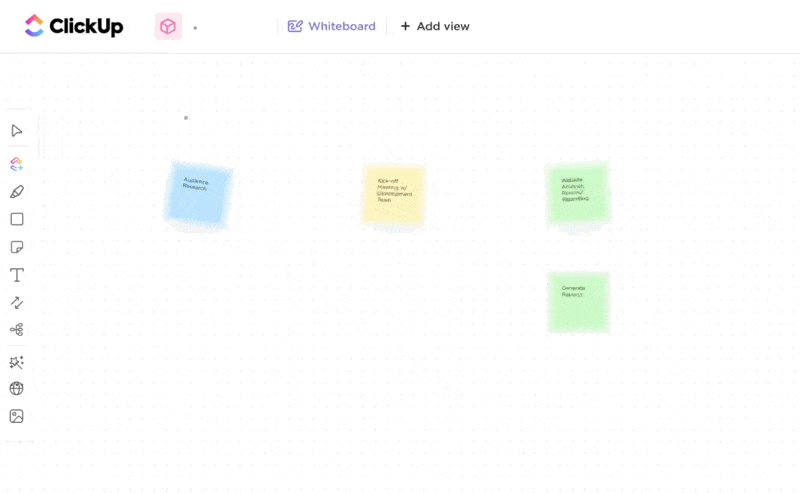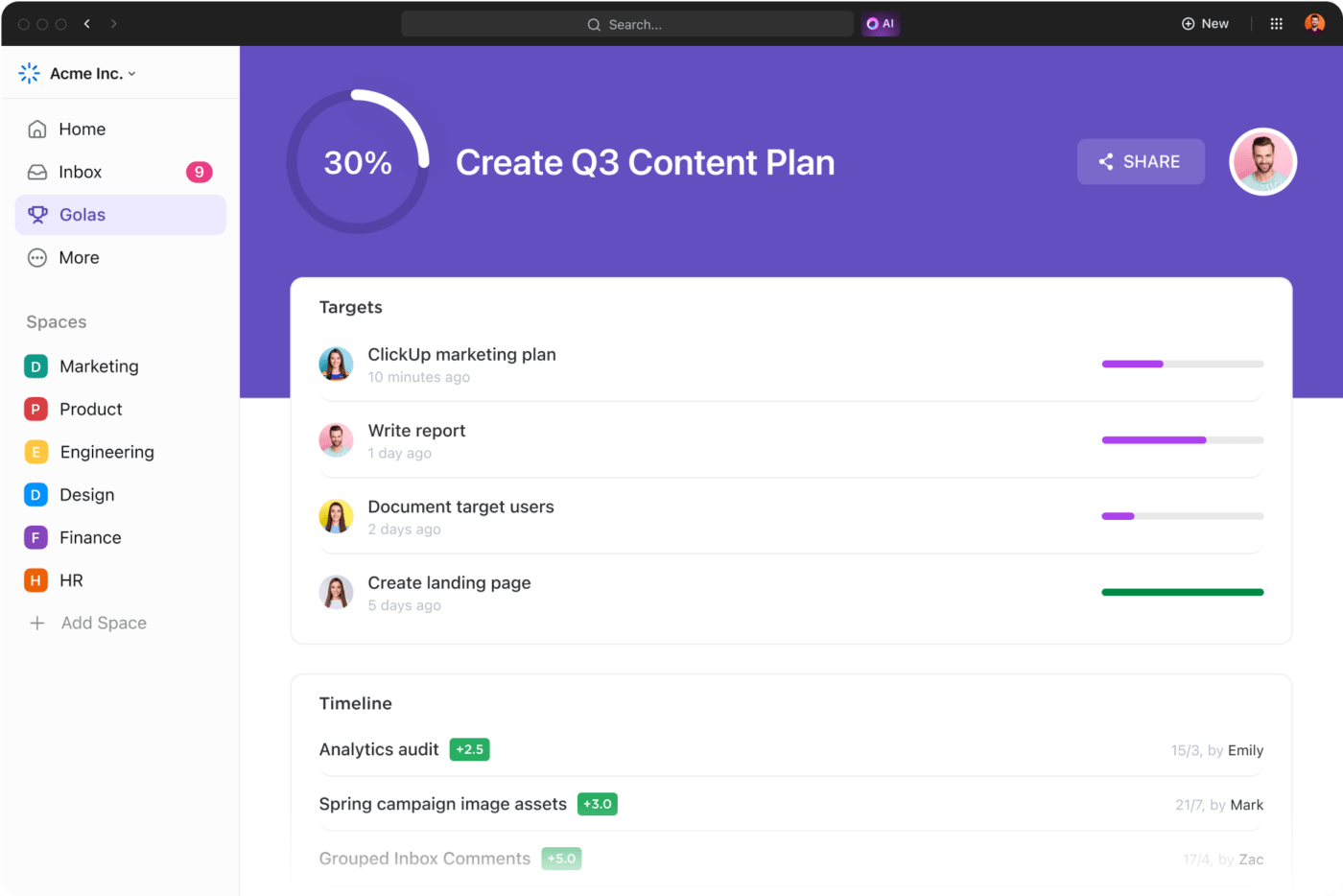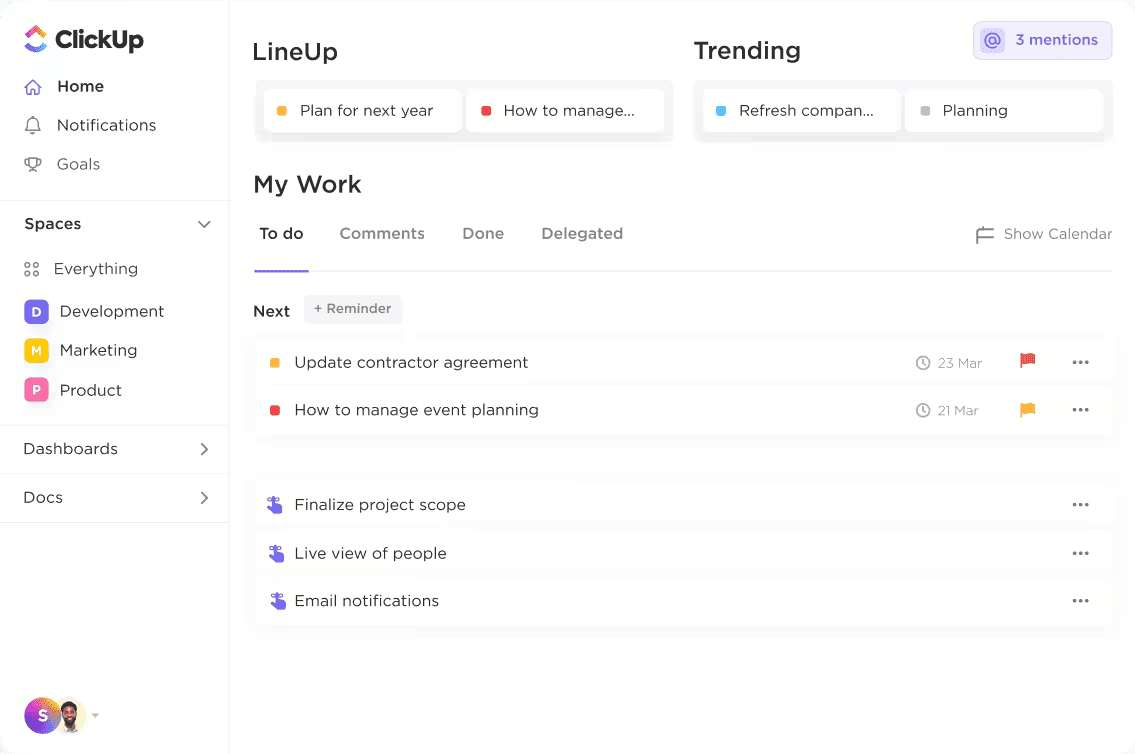Goal Gradient Effect: How to Improve User Engagement?

Sorry, there were no results found for “”
Sorry, there were no results found for “”
Sorry, there were no results found for “”

Have you ever experienced a last-minute surge of energy to finish a task or win a challenge?
That feeling of pushing harder as you near the finish line, with all your focus and effort coming together at once?
This burst of motivation as you approach professional or personal goals has a name: the Goal Gradient Effect.
In this article, we’ll discuss this phenomenon, explore how it can boost team productivity and customer engagement, and show you how ClickUp can help you harness the Goal Gradient Effect within your organization.
The Goal Gradient Effect, or hypothesis, suggests that humans increase effort to achieve a goal as they approach the finish line. When a gradient intensifies in color as it nears one end, the growing sense of progress fuels even greater effort and focus.
Behavioral psychologist Clark L. Hull first proposed this psychological principle in 1934, and it remains relevant to this day with applications across industries, such as psychology, marketing, productivity, and user experience design.

The Goal Gradient Effect has crucial user experience (UX) design applications. It can significantly increase the likelihood of your users completing a process, such as a sign-up or a purchase.
Here are some of the ways to apply it in UX design:
The Goal Gradient Effect works because of many underlying psychological factors related to human behavior, such as:
Here’s how you can use these mechanisms to integrate the Goal Gradient Effect into your work:
‘Moving the Finish Line’ refers to extending a task slightly—right before the user believes they are finished—to maintain or even amplify motivation. The idea is to keep users engaged by slightly extending their journey but still making the reward feel within reach.
Example: After adding items to the cart and reaching checkout, users are prompted: ‘You’re $10 away from free shipping!’
Next, design your business processes and user experiences to motivate people. You can:
Example: Loyalty programs of a coffee shop give users a head start: ‘Congratulations on signing up for Brew Rewards! You start with 2 out of 10 stamps on your coffee card.’
Offering rewards, even if they’re virtual, can enhance a user’s ability to pursue a goal. You can tie gamification features, like rewards, badges, leaderboards, and virtual currencies, to a goal to create a sense of achievement and encourage consistency. It has the excitement of a video game—users will level up, unlock perks, and keep chasing the next target!
Example: A productivity tool rewards users for progressing toward their long-term goal: ‘You’ve earned the ‘Progressive Planner’ badge for completing 3 out of 5 milestones on your ‘Launch Marketing Campaign’ goal.’
Let’s look at three major examples of how it helps the business interests of some popular apps:
Duolingo uses the Goal Gradient Effect to keep you motivated while learning a new language. The app tracks your streak, showing off how many days in a row you’ve completed a lesson. Set a ‘Streak Goal’, and you get a reward each time you hit your target.
You can use a ‘Streak Freeze’ to save your progress, keeping your streak intact. And just in case you need a visual push, the progress bar fills up, letting you see exactly how close you are to unlocking your next reward.

Amazon leverages the Goal Gradient Hypothesis in many ways, but the best example is seen in its Prime Day promotions for purchase acceleration. As you shop, a progress bar shows how close you are to unlocking the next membership tier.
The closer you get, the more excited you get about those exclusive deals and promotions just waiting to be snatched up because who doesn’t love a good deal?
LinkedIn uses a Profile Strength Indicator to show users a visual representation of how close they are to having a perfect profile. This encourages users to fill up as much information as possible in their profiles, making it easy for recruiters to get an in-depth look into their backgrounds.
Moreover, the LinkedIn Easy Apply option splits long job application forms into multiple steps, with a progress indicator showing them how close they are to completing their application.

Applying the Goal Gradient Effect to business processes is a great way to tap into the goal-chasing mindset and boost engagement. Whether it’s signing up, filling out forms, or completing surveys, goals can make people feel motivated to finish. They see the finish line, and they want to cross it!
Let’s discuss four simple ways in which your marketing team can use the Goal Gradient Effect to plan and drive strategic marketing initiatives:
The first step is to visualize your customer journey and identify all customer interaction touchpoints. Once you know each step in a customer’s buying journey and each interaction they have with your brand, you can start improving it strategically using the Goal Gradient Effect.
ClickUp’s Customer Journey Map Template maps out the entire customer journey and highlights any bumps they may face along the way.
These insights help you use the Goal Gradient Hypothesis effectively to speed up goal completion for your users and help them find your product’s ‘aha’ moment!
Additionally, ClickUp Whiteboards allow real-time collaboration with team members, so your sales or marketing department colleagues can contribute to the visualization exercise in real time and no touchpoint is missed.

💡Pro Tip: Conduct customer behavior analysis to understand what drives purchasing decisions to tailor strategies that use the Goal Gradient Effect.
Now that you know all the customer touchpoints, the next step is to integrate gamification into them to harness the power of the Goal Gradient Effect. Whether it’s a sign-up form or a checkout page, introducing gamification elements like visual progress bars or rewards can increase conversion rates.
By defining specific, measurable targets (e.g., website traffic, lead generation, conversion rates), teams can monitor their performance in real time and make data-driven adjustments.
This involves establishing clear milestones and tracking progress towards those milestones, whether they are numerical targets (e.g., “increase website traffic by 20%”), monetary targets (e.g., “generate $10,000 in revenue”), or binary targets (e.g., “launch new marketing campaign by the end of quarter”). This approach allows for continuous monitoring of marketing initiatives and ensures alignment with overall business objectives.
ClickUp Goals, the goal-tracking feature built into ClickUp, allows you to set goals and milestones for each project and associated tasks. You can see the outcomes of your marketing initiatives in real time and create number, monetary, or true/false targets based on the metrics you are tracking.

Some examples of marketing goals and targets you can visualize using this feature include:
➡️ Read More: 10 Best Goal Tracking Apps
Visualizing the progress of your entire conversion funnel is key to understanding how close you are to landing a customer.
By tracking leads at each stage of the funnel, teams can gain valuable insights into the sales process. This can be achieved through custom dashboards that provide a clear overview of lead movement.
With tools like progress bars, graphs, and charts, you can also visualize data over time, making it easy to spot trends, seasonal changes, or emerging patterns. For example, you might notice that sales tend to spike in the middle of the festive season or after a particular marketing campaign.
Ready to get started? Monitor the progress of your entire conversion funnel using ClickUp Dashboards. Just set up a custom sales dashboard and make it available to your sales team members so they can see the leads at each funnel stage.

The Goal Gradient Effect and its impact can be maximized when combined with other motivating factors and strategies that push people to accomplish goals.
Let’s look at some internal and external use cases.
Creating reward systems isn’t just handing out prizes—it’s making users feel excited and motivated every step of the way. The trick is to balance quick wins with long-term goals. When done right, rewards drive engagement and make customers feel consistently accomplished.
Follow these best practices:
✅ Keep customers motivated with rewards that are relevant and align with preferences and behaviors
✅ Provide small, instant rewards for frequent actions, and larger, more valuable rewards for long-term achievements
✅ Use tiered rewards to create a sense of progression and encourage customers to push for the next level
✅ Prevent the onset of negative emotions, such as frustration from unrealistic goals, by keeping objectives smaller and achievable
Simply setting goals isn’t enough to motivate people. To encourage them to achieve their goals, their progress should be visualized to help them see how far they’ve come and how close they are to reaching the reward.
To do this:
✅ Break big goals into smaller, achievable milestones to make them feel manageable and provide a sense of accomplishment along the way
✅ Gamify the goal process by introducing badges, points, or levels
✅ Incorporate leaderboards, team challenges, and community-based rewards to foster engagement
When using the Goal Gradient Effect to maximize team productivity, use it in tandem with time-tracking features.
Time tracking can help individuals understand how much time is spent on tasks, leading to better prioritization and focus. ClickUp Time Tracking helps track how much time your employees spend to complete each task, enabling you to use that information to set project goals strategically.

🍭 Bonus: Customize ClickUp’s Time Tracking for your needs
Need extra power? If any of the tasks in your project are running behind schedule, nudge the employees assigned to those tasks to finish them faster via ClickUp Reminders. It helps send automated preset reminders to keep your team focused as deadlines approach for each project.
🌻 Example: For a product development team working on a new feature, ClickUp Reminders can automatically send reminders to the development, testing, and quality assurance teams as deadlines approach. This keeps everyone on track and ensures that tasks aren’t left until the last minute.

The best part about the Goal Gradient Effect is its versatility—it can enhance customer experience and drive higher employee engagement. The only key is to tailor employee and customer experiences to make goals achievable, relevant, and personalized.
To do this:
✅ Custom goals: Provide customized challenges to ensure people are always working on a goal that is challenging and achievable, which increases motivation and engagement
✅ Feedback and achievements: Offer real-time, adaptive feedback and celebrate milestones to keep people motivated and on track
✅ Team-based goals: Create opportunities to connect people with shared interests and bind them together to achieve a shared goal
Goal Gradient Effect is one of the most powerful ways to encourage your users to complete an action. You can also integrate gamification and progress visualization features into your business processes, encouraging your employees to march more aggressively toward their goals.
ClickUp makes integrating all these features into your work much simpler. Its goal tracking, time tracking, project management, and collaboration features make it easy for your team members to visualize their progress and work collectively to achieve business goals.
Sign up to ClickUp today and maximize your team’s productivity!
© 2025 ClickUp